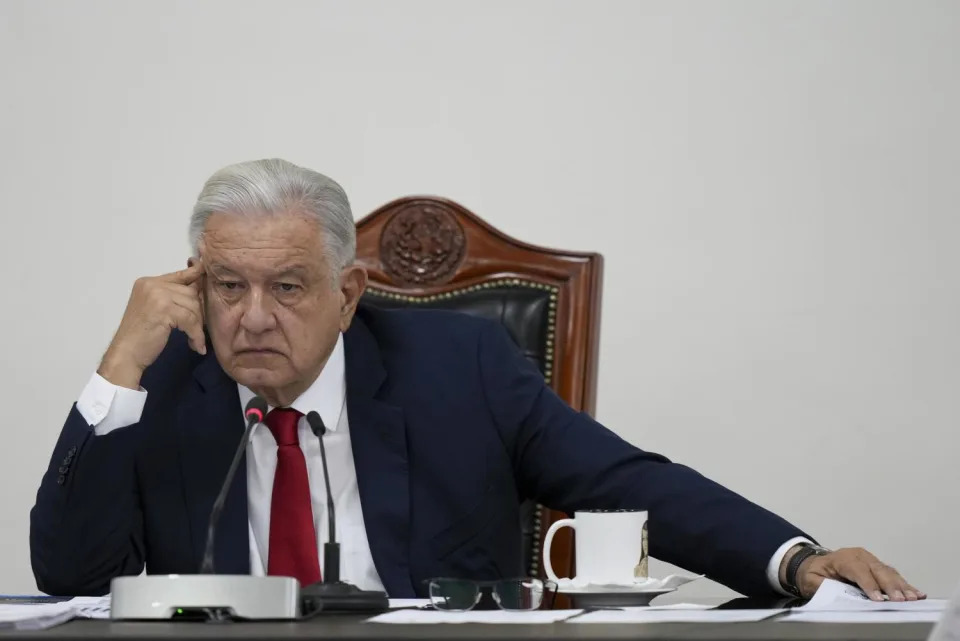The tale of kidnapping, secret deals and betrayal that saw two of Mexico’s most wanted drug lords taken into U.S. custody last month has taken another twist.
Now, top Mexican officials say investigators may have faked evidence in a politician’s killing the same day that kingpins Ismael “El Mayo” Zambada and Joaquín Guzmán López were detained. Those federal officials are demanding answers from prosecutors in Sinaloa state about why they allowed the slain politician’s body to be cremated as well as other oddities in the handling of the case.
And Mexico’s president is left scrambling to explain how a close political ally — Sinaloa Gov. Rubén Rocha Moya — got mixed up in the escalating scandal.

Mexican President Andrés Manuel López Obrador meets with his security cabinet at the National Palace in Mexico City on Aug. 2. (Fernando Llano / Associated Press)
Citing “contradictions … from the very start,” President Andrés Manuel López Obrador told reporters Friday, “There are things that don’t add up.”
Sinaloa’s chief prosecutor, Sara Bruna Quiñónez Estrada, resigned the same day under pressure from Mexico’s attorney general.
Read more: From jail, drug lord ‘El Mayo’ Zambada tells wild story of corruption and murder
It was a written statement last week from Zambada, now jailed in the United States, that upped the pressure on Mexican authorities to explain what happened.
Zambada, 76, wrote that Guzmán López, his 38-year-old godson, had invited him to a July 25 meeting outside Sinaloa’s capital, Culiacán, to help settle a dispute between Rocha and another Sinaloa politician, Héctor Melesio Cuén Ojeda — but that it turned out to be a ruse.
Zambada said he was ambushed by Guzmán López and his men, tied up, driven away and unwillingly put on the plane to the United States. Guzmán López, he said, zip-tied him to a seat for the duration of the flight to a small airport near El Paso, where both were arrested upon landing.
Cuén, a former mayor of Culiacán and leader of his own political party, was shot dead during the kidnapping, according to Zambada.
In contrast, Sinaloa investigators concluded that Cuén was shot dead during a robbery attempt at a gas station — an account that Mexico’s attorney general, Alejandro Gertz Manero, has called into question.
Security footage released by state authorities shows Cuén’s truck pulling into a gas station on the night of Zambada’s arrest. As an attendant starts to pump gas, two men on a motorcycle pull up along the passenger side and one briefly reaches inside after opening the door. The truck and the motorcycle then speed off.
Among many inconsistencies the attorney general has flagged, the Sinaloa prosecutors said that Cuén’s body had four gunshot wounds — while only one shot can be heard on surveillance footage from the gas station, which was released to the public with no sound included. Three employees at the station said they heard no shots.
The federal authorities said the Sinaloan investigators violated standard protocol for homicide inquiries by allowing Cuén’s remains to be cremated and did not process crime scene evidence from the truck or gas station.
The Mexico City officials noted blood in the bed of the pickup truck that was left unexplained by the local investigators, along with an apparent blow to the head that Cuén had suffered despite no indication of a physical struggle in the security footage.
Read more: The secretive life — and stunning downfall — of Sinaloa cartel boss ‘El Mayo’ Zambada
For his part, Rocha has denied attending a meeting with the kingpins or Cuén and said he knew nothing about the event.
The governor, a member of the president’s Morena party, has also denied any connection to drug trafficking. He called himself a victim of “stigma” because he hails from Badiraguato — the birthplace of many prominent cartel leaders, including Joaquín “El Chapo” Guzmán Loera, who co-founded the Sinaloa cartel with Zambada and is serving a life sentence in the United States.
After El Chapo’s arrest, his sons, including Guzmán López, formed their own cartel faction — Los Chapitos — and cracks began to form in the longstanding alliance with Zambada.
Federal officials in Mexico said they were blindsided when Zambada and Guzmán López were taken into U.S. custody and have demanded that the Justice Department hand over details, including the plane’s history, its flight path and the identity of the pilot.

The U.S. ambassador to Mexico, Ken Salazar, arrives for a press conference in Mexico City on Friday. (Alfredo Estrella / AFP via Getty Images)
Ken Salazar, the U.S. ambassador in Mexico City, has said that the aircraft was not a U.S. government plane and that no flight plan was submitted in advance. The pilot was not a U.S. citizen and was not employed or contracted by the United States, the ambassador told reporters.
Federal prosecutors in El Paso moved last week to have Zambada transferred to Brooklyn, where a superseding indictment filed in February accuses him of manufacturing illicit fentanyl and trafficking it to the United States.
Read more: Soldiers and civilians are dying as Mexican cartels embrace a terrifying new weapon: Land mines
If a judge approves the move, Zambada’s case would likely be heard before the same court that handled the 2019 trial of his former partner, El Chapo.
The Brooklyn court is familiar territory for the Zambada family. El Mayo’s brother, Jesús “El Rey” Zambada, and eldest son, Vicente Zambada Niebla, both testified against El Chapo, along with several other former high-ranking cartel members who could also potentially serve as witnesses for the prosecution if there is another trial.
Mexican authorities have alleged that Guzmán López and his brother Ovidio, also in U.S. custody and facing federal charges, formed “a pact” to deliver Zambada in hopes of receiving leniency. The Justice Department has declined to comment on their cases, and the brothers’ lawyer has repeatedly denied any cooperation agreements.
San Miguel Times
Newsroom

